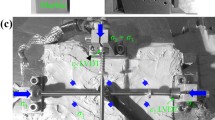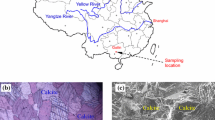Abstract
Triaxial compression experiments were carried out on deep-buried marble specimens to investigate their short-term and creep mechanical behavior under cyclic loading. First, based on the results of short-term triaxial experiments, the elastic, plastic, and strength behaviors of marble were analyzed. The results show that for the same confining pressure, the elastic modulus of marble remains basically constant at the lower axial deviatoric level but decreases slowly after yielding strength; in contrast, the plastic modulus reduces rapidly with the increase of axial deviatoric stress. However, the elastic and plastic moduli of the tested marble were quite independent of the confining pressure. The relationship between axial deviatoric stress and plastic deformation of marble can be described well by the interface model. The peak strength of marble under higher stress increases with the confining pressure, which can be better described in accordance with the Mohr–Coulomb criterion. And then, in accordance with the experimental results of marble creep under triaxial cyclic loading, the instant elastic and plastic strains, and the visco-elastic and visco-plastic strains were all separated successfully, which provided a better foundation for constructing a visco-elasto-plastic creep model of rock. The creep strain rate of marble under different deviatoric stresses is analyzed, which shows that the steady-state creep rate of marble increases nonlinearly with the increase of axial deviatoric stress. In the end, the creep mechanical behavior of marble under cyclic loading is theoretically analyzed using the creep model. The results show that Burgers creep model can describe the creep behavior of marble under the loading condition satisfactorily but is inadequate to describe the creep behavior of marble under the unloading condition. Therefore, by adopting the fundamental hypothesis of visco-plastic mechanics, a visco-elasto-plastic creep model of rock material is constructed, which can describe the unloading creep behavior of marble better than Burgers creep model. The creep model curve agrees very well with the experimental results, which verifies the proposed visco-elasto-plastic creep model.














Similar content being viewed by others
References
Aliha MRM (2013) Indirect tensile test assessments for rock materials using 3-D disc-type specimens. Arab J Geosci. doi:10.1007/s12517-013-1037-8
Aydan O, Ito T, Ozbay U, Kwasniewski M, Shariar K, Okuno T, Ozgenoglu A, Malan DF, Okada T (2014) ISRM suggested methods for determining the creep characteristics of rock. Rock Mech Rock Eng 47(1):275–290
Chen BR, Zhang XJ, Feng XT, Zhao HB, Wang SY (2013) Time-dependent damage constitutive model for the marble in the Jinping II hydropower station in China. Bull Eng Geol Environ. doi:10.1007/s10064-013-0542-z
Chen L, Wang CP, Liu JF, Liu YM, Liu J, Su R, Wang J (2014) A damage-mechanism-based creep model considering temperature effect in granite. Mech Res Commun 56:76–82
Cristescu N, Hunche U (1998) Time effects in rock mechanics. Wiley, New York
Dafalias YF, Popov EP (1975) A model of nonlinearly hardening materials for complex loading. Acta Mec 21:173–192
Fairhurst CE, Hudson JA (1999) Draft ISRM suggested method for the complete stress-strain curve for the intact rock in uniaxial compression. Int J Rock Mech 1000 Sci 36(3):279–289
Fujii Y, Kiyama T, Ishijima Y, Kodama J (1999) Circumferential strain behavior during creep tests of brittle rocks. Int J Rock Mech Min Sci 36(3):323–337
Huang D, Li YR (2014) Conversion of strain energy in triaxial unloading tests on marble. Int J Rock Mech Min Sci 66:160–168
Jiang Q, Feng XT, Xiang TB, Su GS (2010) Rockburst characteristics and numerical simulation based on a new energy index: a case study of a tunnel at 2500 m depth. Bull Eng Geol Environ 69:381–388
Jiao YY, Song L, Wang XZ, Adoko AC (2013a) Improvement of the U-shaped steel sets for supporting the roadways in loose coal seam. Int J Rock M Mining Sci 60:19–25
Jiao YY, Wang ZH, Wang XZ, Adoko AC, Yang ZX (2013b) Stability assessment of an ancient landslide crossed by two coal mine tunnels. Eng Geol 159:36–44
Li SJ, Feng XT, Li ZH (2012a) Evolution of fractures in the excavation damaged zone of a deeply buried tunnel during TBM construction. Int J Rock M Mining Sci 55(10):125–138
Li SJ, Feng XT, Li ZH, Chen BR, Zhang CQ, Zhou H (2012b) In situ monitoring of rockburst nucleation and evolution in the deeply buried tunnels of Jinping II hydropower station. Eng Geol 137(138):85–96
Li XP, Zhao H, Wang B, Xiao TL (2013) Mechanical properties of deep-buried marble material under loading and unloading tests. Wuhan Univ Technol-Mater 28(3):514–520
Lin P, Liu XL, Zhou WY, Wang RK, Wang SY (2014) Cracking, stability and slope reinforcement analysis relating to the Jinping dam based on a geomechanical model test. Arab J Geosci. doi:10.1007/s12517-014-1529-1
Liu X (1994) An introduction to rock rheology. Geological Publishing Press, Beijing
Ma L, Daemen JJK (2006) An experimental study on creep of welded tuff. Int J Rock Mech Min Sci 43(2):282–291
Maranini E, Yamaguchi T (2001) A non-associated viscoplastic model for the behaviour of granite in triaxial compression. Mech Mater 33(5):283–293
Martin CD, Chandler NA (1994) The progressive fracture of Lac du Bonnet granite. Int J Rock Mech Min Sci Geomech Abstr 31(6):643–659
Miura K, Okui Y, Horii H (2003) Micromechanics-based prediction of creep failure of hard rock for long-term safety of high-level radioactive waste disposal system. Mech Mater 35:587–601
Nadimi S, Shahriar K (2014) Experimental creep test and prediction of long-term creep behavior of grouting material. Arab J Geosci 7:3251–3257
Qiu SL, Feng XT, Xiao JQ, Zhang CQ (2014) An experimental study on the pre-peak unloading damage evolution of marble. Rock Mech Rock Eng 47:401–409
Shao JF, Chau KT, Feng XT (2006) Modeling of anisotropic damage and creep deformation in brittle rocks. Int J Rock Mech Min Sci 43:582–592
Sun J (1999) Rheological behavior of geomaterials and its engineering applications. China Architecture and Building Press, Beijing
Wu SY, Shen MB, Wang J (2010) Jinping hydropower project: main technical issues on engineering geology and rock mass. Bull Eng Geol Environ 69:325–332
Xiong LX, Li TB, Yang LD, Yuan XW (2014) A study on stationary and nonstationary viscoelastic models of greenschist. Arab J Geosci. doi:10.1007/s12517-014-1390-2
Yang SQ, Cheng L (2011) Non-stationary and nonlinear visco-elastic shear creep model for shale. Int J Rock Mech Min Sci 48(6):1011–1020
Yang CH, Daemen JJK (1997) Temperature effects on creep of tuff and its time-dependent damage analysis. Int J Rock Mech Min Sci 34(3/4)345.e1–345.e12.
Yang SQ, Jiang YZ (2010) Triaxial mechanical creep behavior of sandstone. Min Sci Tech 20(3):339–349
Yang SQ, Xu WY, Xie SY, Shao JF (2006) Studies on triaxial rheological deformation and failure mechanism of hard rock in saturated state. Chin J Geotech Eng 28(8):962–969
Yang SQ, Jing HW, Cheng L (2014) Influences of pore pressure on short-term and creep mechanical behavior of red sandstone. Eng Geol 179:10–23
Acknowledgments
This research was supported by the National Basic Research Program (973) of China (Grant Nos. 2014CB046905 and 2013CB036003), National Natural Science Foundation of China (Grant Nos. 41272344 and 51109014), the Natural Science Foundation of Jiangsu Province of China (Grant No. BK2012568), and the Fundamental Research Funds for the Central Universities (China University of Mining and Technology) (Grant Nos. 2014YC10 and 2014XT03). The first author obtained financial support from a 2014 Endeavour Research Fellowship in Australia, which was greatly appreciated. We also would like to express our sincere gratitude to the editor and the anonymous reviewers for their valuable comments, which have greatly improved this paper.
Author information
Authors and Affiliations
Corresponding author
Rights and permissions
About this article
Cite this article
Yang, SQ., Xu, P., Ranjith, P.G. et al. Evaluation of creep mechanical behavior of deep-buried marble under triaxial cyclic loading. Arab J Geosci 8, 6567–6582 (2015). https://doi.org/10.1007/s12517-014-1708-0
Received:
Accepted:
Published:
Issue Date:
DOI: https://doi.org/10.1007/s12517-014-1708-0




